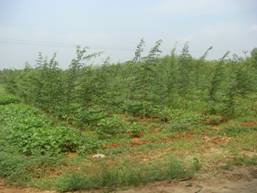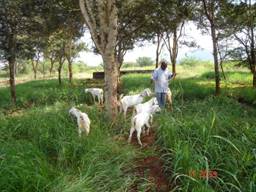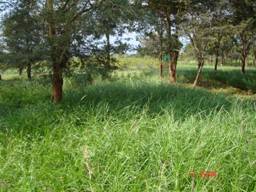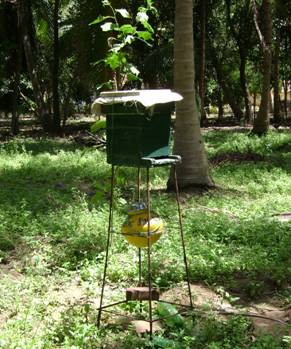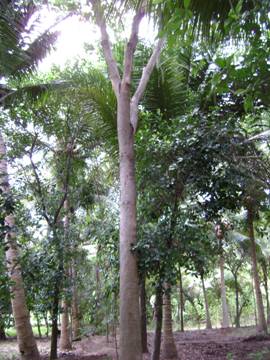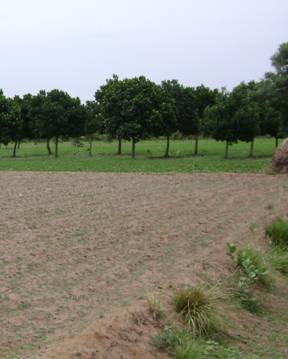Agroforestry is a collective name for land-use systems involving trees combined with crops and/or animals on the same unit of land. It combines
1) Production of multiple outputs with protection of the resource base;
2) Places emphasis on the use of multiple indigenous trees and shrubs;
3) Particularly suitable for low-input conditions and fragile environments;
4) It involves the interplay of socio-cultural values more than in most other land-use systems; and
5) It is structurally and functionally more complex than monoculture.
1) Agroforestry is any sustainable land-use system that maintains or increases total yields by combining food crops (annuals) with tree crops (perennials) and/or livestock on the same unit of land, either alternately or at the same time, using management practices that suit the social and cultural characteristics of the local people and the economic and ecological conditions of the area.
2) Agroforestry is a collective name for a land-use system and technology whereby woody perennials are deliberately used on the same land management unit as agricultural crops and/or animals in some form of spatial arrangement or temporal sequence. In an agroforestry system there are both ecological and economical interactions between the various components.
DIFFERENCE BETWEEN SOCIAL FORESTRY AND AGROFORESTRY
|
|
Social forestry is defined as “Forestry outside the conventional forests which primarily aim at providing continuous flow of goods and services for the benefit of people. This definition implies that the production of forest goods for the needs of the local people is Social forestry. Thus, social forestry aims at growing forests of the choice of the local population.
Shah (1985) stated that Conceptually Social forestry deals with poor people to produce goods such as fuel, fodder etc. to meet the needs of the local community particularly underprivileged section.
DIFFERENT TERMINOLOGIES FOR DESCRIBING TREE CULTIVATION IN NON-FOREST AREAS
|
|
1) Farm Forestry: Farm forestry is the name given to programmes which promote commercial tree growing by farmers on their own land. Farm forestry was defined by NCA (1976) as the practice of forestry in all its aspects in and the around the farms or village lands integrated with other farm operations.
2) Extension Forestry: It is the practice of forestry in areas devoid of tree growth and other vegetation situated in places away from the conventional forest areas with the object of increasing the area under tree growth.
It includes the following.
a) Mixed forestry
It is the practice of forestry for raising fodder grass with scattered fodder trees, fruit trees and fuel wood trees on suitable wastelands, panchayat lands and village commons
b) Shelterbelts
Shelterbelt is defined as a belt of trees and or shrubs maintained for the purpose of shelter from wind, sun, snow drift, etc.
c) Linear Strip plantations
These are the plantations of fast growing species on linear strips of land.
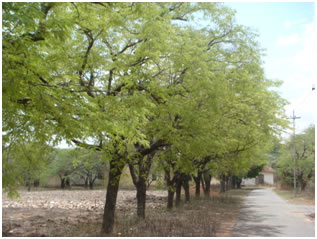
Linear strip plantations |
3) Rehabilitation of Degraded forests: The degraded area under forests needs immediate attention for ecological restoration and for meeting the socio economic needs of the communities living in and around such areas.
4) Recreation Forestry: It is the practice of forestry with the object of raising flowering trees and shrubs mainly to serve as recreation forests for the urban and rural population. This type of forestry is also known as Aesthetic forestry which is defined as the practice of forestry with the object of developing or maintaining a forest of high scenic value.
TYPES OF AGROFORESTRY SYSTEMS
|
|
1. STRUCTURAL BASIS :
A. NATURE OF COMPONENTS
I) AGRISILVICULTURAL SYSTEMS
In this system, agricultural crops are intercropped with tree crops in the interspace between the trees. Under this system agricultural crops can be grown upto two years under protective irrigated condition and under rainfed farming upto four years. The crops can be grown profitably upto the above said period beyond which it is uneconomical to grow grain crops. However fodder crops, shade loving crops and shallow rooted crops can be grown economically. Wider spacing is adopted without sacrificing tree population for easy cultural operation and to get more sunlight to the intercrop. Performance of the tree crops is better in this system when compared to monoculture.
II) SILVOPASTORAL SYSTEMS |
|
The production of woody plants combined with pasture is referred to Silvipasture system. The trees and shrubs may be used primarily to
produce fodder for livestock or they may be grown for timber, fuelwood, fruit or to improve the soil.
This system is classified in to three categories
a) Protein bank
b) Livefence of fodder trees and hedges
c) Trees and shrubs on pasture
|
a) Protein bank:
In this Silvipastoral system, various multipurpose trees (protein rich trees) are planted in or around farmlands and range lands for cut and carry fodder production to meet the feed requirement of livestock during the fodder deficit period in winter.
Example: Acacia nilotica, Albizia lebbeck, Azadirachta indica, Leucaena leucocephala, Gliricidia sepium, Sesbania grandiflora
b) Livefence of fodder trees and hedges:
In this system, various fodder trees and hedges are planted as live fence to protect the property from stray animals or other biotic influences.
Example: Gliricidia sepium, Sesbania grandiflora, Erythrina sp, Acacia sp.
c) Trees and shrubs on pasture:
In this system, various tree and shrub species are scattered irregularly or arranged according to some systemic pattern to supplement forage production.
Example: Acacia nilotica, Acacia leucophloea ,Tamarindus indica, Azadirachta indica.
III) AGROSILVOPASTORAL SYSTEMS
|
|
The production of woody perennials combined with annuals and pastures is referred Agrisilvopastural system.
This system is grouped into two categories.
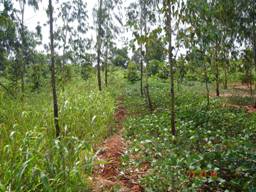
a) Home gardens
b) Woody hedgerows for browse, mulch, green manure and soil conservation |
a) Home gardens
This system is found extensively in high rainfall areas in tropical South and South east Asia. This practice finds expression in the states of Kerala and Tamil Nadu with humid tropical climates where coconut is the main crop. Many species of trees, bushes , vegetables and other herbaceous plants are grown in dense and in random or spatial and temporal arrangements. Most home gardens also support a variety of animals. Fodder grass and legumes are also grown to meet the fodder requirement of cattle. In India, every homestead has around 0.20 to 0.50 ha land for personal production.
Home gardens represent land use systems involving deliberate management of multipurpose trees and shrubs in intimate association with annual and perennial agricultural crops and livestock within the compounds of individual houses. The whole tree- crop- animal units are being intensively managed by family labour. Home gardens can also be called as Multitier system or Multitier cropping.
Home gardens are highly productive, sustainable and very practicable. Food production is primary function of most home gardens.
Structure of Home Gardens:
Home gardens are characterized by high species diversity and usually 3-4 vertical canopy strata. The layered configuration and compatible species admixture are the most conspicuous characteristics of all home gardens. Generally all home gardens consist of an herbaceous layer near the ground, a tree layer at the upper levels and an intermediate layer. The lower layer can be partitioned into two, the lowermost being at less than 1.0m in height, dominated by different vegetables and the second layer of 1.0 -3.0/m height comprising food crops such as banana, papaya and so on. The upper tree layer can also be divided into two, consisting of emergent , full grown timber and fruit trees occupying the upper most layer of 25m height and medium size trees of 10-20m occupying the next lower layer. The intermediate layer of 5-10m height is dominated by various fruit trees.
Choice of species:
a) Woody species: Anacardium occidentale,Artocarpus heterophyllus, Citrus spp, Psiduim guajava, Mangifera indica, Azadirachta indica, Cocus nucifera,
b) Herbaceous species: Bhendi, Onion, cabbage, Pumpkin, Sweet potato, Banana, Beans, etc.
b) Woody Hedgerows:
In this system various woody hedges, especially fast growing and coppicing fodder shrubs and trees are planted for the purpose of browse, mulch, green manure, soil conservation etc. The following species viz., Erythrina sp, Leucaena luecocephala, Sesbania grandiflora are generally used.
a) Apiculture with trees: In this system various honey (nector) producing trees frequently visited by honeybees are planted on the boundary of the agricultural fields
b) Aquaforestry: In this system various trees and shrubs preferred by fish are planted on the boundary and around fish ponds. Tree leaves are used as feed for fish. The main role of this system is fish production and bund stabilization around fish ponds
c) Mixed wood lots: In this system, special location specific MultiPurpose Trees ( MPTs) are grown mixed or separately planted for various purposes such as wood, fodder, soil conservation , soil reclamation etc.
B. ARRANGEMENT OF COMPONENTS |
|
I) Spatial arrangement
II) Temporal arrangement |
) Spatial Arrangement: Spatial arrangement of plants in an agroforestry mixture may result in dense mixed stands ( as in home gardens) or in sparse mixed stands ( as in most systems of trees in pastures).
b) Temporal Arrangement: Temporal arrangements of plants in Agroforestry may also take various forms. An extreme example is the conventional shifting cultivation cycles involving 2-4 years of cropping and more than 15 years of fallow cycle, when a selected woody species or mixtures of species may be planted. Similarly, some silvipastoral systems may involve grass leys in rotation with some species of grass remaining on the land for several years. These temporal arrangement of components in agroforestry are termed coincident, concomitant, overlapping, separate and interpolated.
All agroforestry systems have two functions.
A) Productive functions,
B) Protective functions
A) Productive functions
The Productive functions are:
I) Food
II) Fodder
III) Fuel wood
IV) Cloths
V) Shelter
VI) NTFPs |
B) Protective functions
The Protective functions are:
i) Wind breaks
II) Shelterbelts
III) Soil conservation
IV) Soil improvement |
3. SOCIO-ECONOMIC CLASSIFICATION |
|
Based on socioeconomic criteria as scale of production and level of technology input and management, agroforestry systems have been grouped in to three categories.
A) Commercial Agroforestry systems
B) Intermediate Agroforestry systems
C) Subsistence Agroforestry systems
A) Commercial AF systems:
The term commercial is used whenever the scale of the production of the output is the major aim of the system.
Examples:
a) Commercial production of plantation crops such as rubber, oilpalm, and coconut with permanent underplanting of food crops, pastures
b) Commercial production shade tolerating plantation crops such as coffee, tea and cocoa under overstorey of shade trees
B) Intermediate AF systems:
Intermediate systems are those between commercial and subsistence scale of production and management.
Examples:
Production of perennial cash crops and subsistence food crops undertaken on farms wherein the cash crops fulfill the cash needs and the food crops meet the family‘s food needs.
C) Subsistence AF systems:
Subsistence AF systems are those wherein the use of land is directed towards satisfying basic needs and is managed mostly by the owner and his family.
4.ECOLOGICAL CLASSIFICATION |
|
A) Humid / sub humid
B) Semiarid / arid
C) Highlands
A) Agroforestry systems in Humid / Subhumid lowlandsExamples:
Homegardens, Trees on rangelands and pastures, improved fallow in shifting cultivation and Multipurpose woodlots.
B) Agroforestry systems in Semiarid and arid lands Examples:
Various forms of silvopastoral systems, wind breaks and shelterbelts.
C) Agroforestry systems in Tropical High lands Examples:
Production systems involving plantation crops such as coffee, tea, use of woody perennials in soil conservation and improved fallow.
BENEFITS OF AGROFORESTRY SYSTEM |
|
A) Environmental benefits
i) Reduction of pressure on natural forests.
ii More efficient recycling of nutrients by deep rooted trees on the site
iii) Better protection of ecological systems
iv) Reduction of surface run-off, nutrient leaching and soil erosion through impeding effect of tree roots and stems on these processes
v) Improvement of microclimate, such as lowering of soil surface temperature and reduction of evaporation of soil moisture through a combination of mulching and shading
vi) Increment in soil nutrients through addition and decomposition of litterfall.
vii) Improvement of soil structure through the constant addition of organic matter from decomposed litter.
B) Economic benefits
i) Increment in an outputs of food, fuel wood , fodder, fertiliser and timber;
ii) Reduction in incidence of total crop failure, which is common to single cropping or monoculture systems
iii) Increase in levels of farm income due to improved and sustained productivity
C) Social benefits
i) Improvement in rural living standards from sustained employment and higher income
ii) Improvement in nutrition and health due to increased quality and diversity of food outputs
iii) Stabilization and improvement of communities through elimination of the need to shift sites of farm activities.
|

